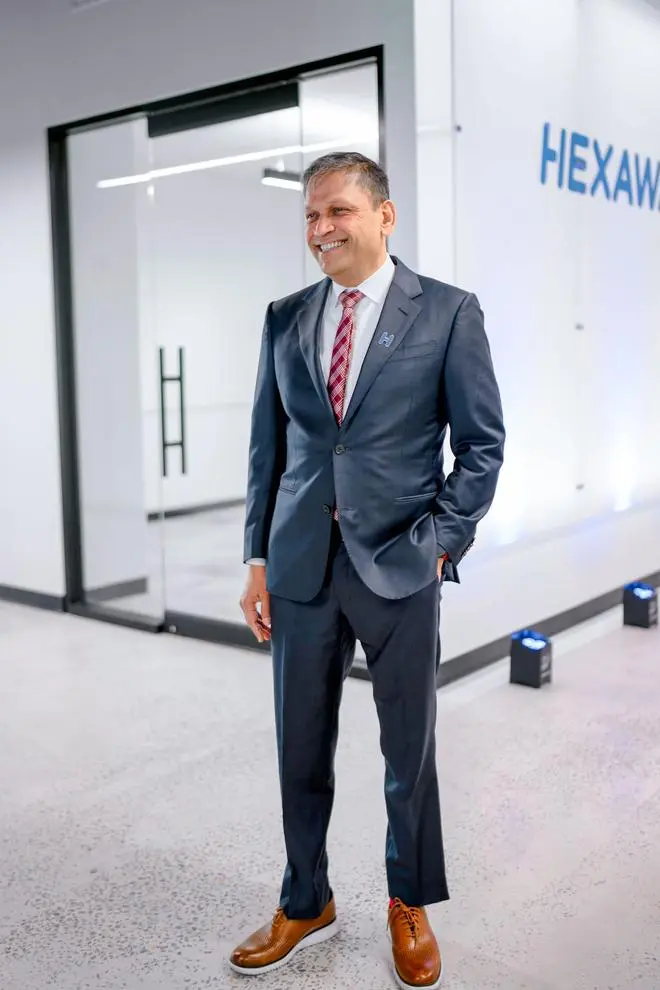
BUILDING FOR THE WORLD: The Hexaware campus in Siruseri, Chennai, is among its largest global delivery centres
For Srikrishna Ramakarthikeyan, CEO and executive director of Hexaware Technologies, a mid-sized IT services firm, home is New Jersey but, as he jocularly puts it, he lives on a plane. He’s zoomed into one of the largest global delivery centres of Hexaware, in Siruseri, on the IT highway in Chennai, on an overnight flight — after spending the previous night too on a plane — and is set for a third straight night flight, to attend a conclave of Hexaware’s top-60 customers in the US.
With its fountains, and well-manicured landscaped gardens and lawns, the Hexaware office is a green oasis of calm off the raucous IT highway, belying the Trump turbulence that has rocked its biggest market, the US, which generates 73 per cent of its revenues. But Ramakarthikeyan isn’t too perturbed by what his US customers may tell him, as he anticipates a second-order impact on financial services, healthcare and insurance.
It’s been almost 11 years since Ramakarthikeyan took over as CEO — a period of key wins and exponential growth that propelled Hexaware into becoming one of the fastest growing IT services firms today. In the decade before his reign, Hexaware had indeed grown about three times, but the Indian IT services industry had grown six-and-a-half times.

Srikrishna Ramakarthikeyan, CEO and executive director, Hexaware Technologies
“Shareholders and founders were happy because they were making a lot of money. But it’s a question of ambition; we had to flip the growth narrative and say we will grow materially faster than the industry average. So, over the last decade, we’ve grown more than 2X the industry average. The start point was changing leadership,” he explains.
Though he hastens to emphasise that the one thing that has not changed is how good Hexaware is with customers. “We do everything to make sure that we meet client commitments. This has been the culture from early on, and we preserved it. Most companies are like this when they are small, but tend to lose the plot when they become bigger. My job is to ensure we preserve this culture,” he says.
But Ramakarthikeyan is well aware that aspects like company culture can change rapidly. He quotes Salesforce founder Marc Benioff, who said this would perhaps be the last generation of CEOs who manage a purely human workforce and, in the future, it will be a hybrid of human and AI workforce. “It’s 70:30 now, but I wouldn’t be surprised if it becomes 50:50 rapidly. And even flips to become 30:70.” However, he sounds a note of caution, citing three barriers to technology adoption: tech capabilities, especially pertaining to AI; trust in the tech; and slow customer adoption.
Growth drivers
Fresh from an IPO, where promoter CA Magnum Holdings diluted 20 per cent of its holdings, Ramakarthikeyan explains that Hexaware has set for itself four growth accelerators. The first is legacy networks’ modernisation, which can be a massive opportunity globally. “Code written 30 years ago is legacy now. Today’s engineers don’t want to spend time fixing that; they want to do cool new stuff,” he adds.
The second area of focus pertains to companies owned by private equity — namely to work for PE companies, or on behalf of them for the companies they own. Smaller PE firms tend to play an active role in management, and Hexaware sees for itself a role there. The third goal is to do more in software engineering for software companies. “We do a lot of software engineering for some of the Big Tech companies. And the idea is to do more for them,” adds Ramakarthikeyan. The fourth target is to do more in India and West Asia. “Because of low margins, we’ve been selective thus far, but we think we’ve been way too selective in such a huge market. So we can still keep margins reasonable and materially increase our business here. It’s okay in a business mix as there could be some pockets which are slightly lower margin than others,” he says.
He points out that there is growth because Hexaware is also targeting the big IT services players, which are present in every industry, sector and geography. “We can grow perhaps 2.5X or 3X by gaining more share of work from existing customers too,” he says.
Employee retention
At Hexaware the top leadership has had long tenures while attrition rate is among the lowest in the industry at around 10.8 per cent. On the high retention at senior management level, Ramakarthikeyan says that much of the initial team comprised either his direct connects on LinkedIn or those who had worked with him in the past. All of them shared the purpose he penned down when taking over the role — ‘Building a great Hexaware’.
Quality work
On the secret sauce behind the lowest attrition rate at industry level, he explains that for engineers the first reason is, unsurprisingly, compensation. A close second, sometimes even first, is the quality of work. “Quality work is super-important for them. You can train people in the coolest technologies, but if they don’t get to use them, what’s the point? There’s lots of new type of work we get that gives us an opportunity to use our skills,” he explains. For instance, for a global digital health company, Hexaware helped build a product that looks like a handheld shaver but is a full-body ultrasound machine. “Typically, in ultrasound machines, you need a different one for different parts of the body, as the required wavelength frequency varies. And it costs quite a lot of money. This company has a single full-body machine, for which we wrote the software and developed the app. This sells for $4,000,” he says.
A Big Tech’s internal corporate network globally is handled by Hexaware. “It’s still one of the most complex networks in the world. We initially won it as a challenger. Their policy is that every major work has to be split with at least two companies. That’s how it started. But after two years they merged 100 per cent of the work with us!” says Ramakarthikeyan, rather pleased.
He points to the embedded software the company developed for a pharma giant. Hexaware also developed the software for the FDA’s first approved digital pill, which contains an ingestible chip. The chip communicates with a patch, and data from the patch is accessed through an app. “It’s a pill for mental health; a lot of them don’t take their medicines. So, it’s for adherence. The second thing it achieves is efficacy,” he says, explaining that it correlates patient information — such as whether they were out in the sun or the number of steps they took — with other factors that are known to have an impact on mental health patients.
Ask Ramakarthikeyan where Hexaware will be five years down the line, and he replies that, size-wise, it would be around $3 billion. “We’ll get more purposeful — I don’t want to use the word ‘aggression’ — with acquisitions. We have a lot more money than we had in the past,” he emphasises.
As the IT industry enters an AI-induced inflexion point, ‘Building a great Hexaware’ remains the guiding motto for Ramakarthikeyan and his more than 32,000-strong team.
More Like This
Published on April 26, 2025






